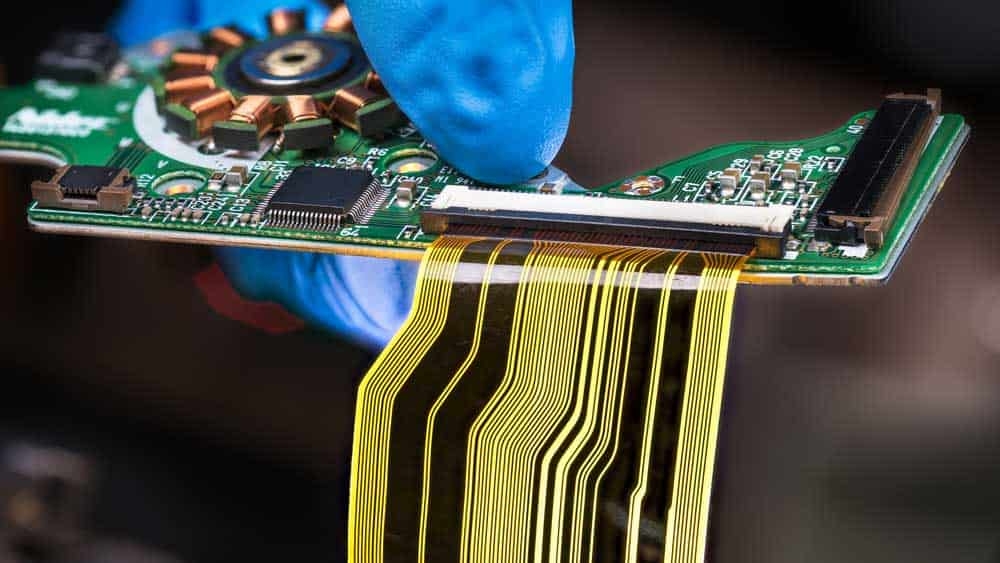Terminated flexible printed circuits, or terminated FPCs, refer to flexible electronic components with specialized endpoints designed for connection and integration within electronic systems. These circuits play a crucial role in modern electronics, facilitating compact and efficient designs. Their ability to bend and conform to various shapes makes them indispensable in applications where traditional rigid circuits fall short. In this article, we will explore the significance of terminated FPCs in the electronics industry, highlighting their role in driving innovation and enabling the development of advanced electronic devices.
Terminated Flexible Printed Circuit Basics
Explanation of Flexible Printed Circuits (FPCs)
Flexible Printed Circuits, or FPCs, are thin, flexible, and lightweight electronic circuits made from flexible materials like polyimide or polyester. They replace traditional rigid PCBs in applications requiring flexibility, space-saving, and shape adaptability.
Terminology and Components
- Substrates: The flexible material on which the circuit traces are etched.
- Conductive traces: Metal traces that carry electrical signals.
- Dielectric layers: Insulating layers between conductive traces.
- Termination points: Endpoints designed for connections in terminated FPCs.
Key Features and Advantages
- Flexibility: Ability to bend, twist, and conform to 3D shapes.
- Size and weight reduction: Ideal for miniaturized devices.
- High reliability: Fewer solder joints and fewer failure points.
- Improved signal integrity: Reduced electromagnetic interference。
Terminating Techniques
Overview of Termination in FPCs
Terminating FPCs involves connecting them to other electronic components or systems. This process is crucial for functionality and integration.

Common Termination Methods
- Soldering
Soldered connections involve melting solder to attach FPC termination points to other components.
Suitable for high-density applications but can be labor-intensive.
- Connectors
Connectors provide a plug-and-play solution, making it easy to connect and disconnect FPCs.
Common connector types include board-to-board connectors and cable-to-board connectors.
- ZIF (Zero Insertion Force) Connectors
ZIF connectors allow FPC insertion without applying excessive force.
Ideal for delicate or fragile FPCs and for applications requiring frequent connections.
- Pressure Contacts
Pressure contacts use mechanical force to establish a connection.
Suitable for applications where soldering is not feasible or connectors are impractical.
- Soldering:
Pros: Strong and durable connections.
Cons: Labor-intensive, heat-sensitive components may be damaged.
- Connectors:
Pros: Easy to install and replace, suitable for frequent connections.
Cons: Added cost and space requirements.
- ZIF Connectors:
Pros: Gentle on FPCs, easy to use.
Cons: Limited to specific FPC designs and applications.
- Pressure Contacts:
Pros: Quick connections, no heat required.
Cons: May require higher insertion force, less durable than soldering.
Applications of Terminated Flexible Printed Circuits
Electronics Industries and Sectors Using Terminated FPCs
- Consumer electronics
- Automotive industry
- Medical devices
- Aerospace and defense
- Wearable technology
Real-World Examples and Case Studies
- Smartphone hinges
- Medical sensor patches
- Automotive dashboard displays
Advantages in Specific Applications
- Consumer electronics: Slimmer and more compact designs.
- Medical devices: Comfortable wearables and improved patient monitoring.
- Aerospace: Reduced weight and space constraints.
- Terminated flexible printed circuits play a pivotal role in various industries, offering unmatched versatility and integration possibilities while optimizing electronic system performance.
Considerations for Design and Implementation
Factors Influencing Terminated FPC Design
- Flexibility and Bend Radius
The degree of flexibility required for the FPC depends on the application.
Bend radius limitations must be considered to avoid damage to conductive traces.
- Environmental Factors
Temperature extremes, humidity, and exposure to chemicals can impact FPC performance.
Design should account for environmental conditions in the target application.
- Electrical Characteristics
Signal integrity, impedance matching, and noise immunity must be maintained.
Proper grounding and shielding are essential for reliable performance.
Design Guidelines and Best Practices
- Trace routing: Optimal trace routing to minimize signal interference.
- Termination point placement: Precise placement for easy integration.
- Avoiding sharp bends: Designing for smooth, gradual bends to prevent stress on traces.
Quality Control and Testing
Rigorous testing to ensure termination points are functional and reliable. Inspection for defects or anomalies in the FPC, such as delamination or broken traces.
Verification of electrical performance in real-world conditions.
Future Trends and Innovations
Emerging Technologies in FPC Termination
Advanced termination methods leveraging nanotechnology for improved conductivity.
Integration of flexible electronics with other emerging technologies, such as IoT and 5G.
Sustainability and Eco-Friendly Termination Methods
Development of termination techniques that reduce the environmental impact of FPC manufacturing. Use of recyclable materials and processes in FPC production.
Potential Advancements and Their Impact on Industries
Enhanced durability and longevity of terminated FPCs, leading to longer-lasting devices.
Integration of terminated FPCs in fields like healthcare, enabling new diagnostic and treatment possibilities. Expansion of FPC applications in automotive, aerospace, and robotics, driving innovation in these sectors.
As terminated flexible printed circuits continue to evolve and find new applications, it is essential for designers and manufacturers to stay at the forefront of these developments. By considering design factors, adhering to best practices, and embracing emerging technologies, the future of terminated FPCs promises exciting advancements and sustainable solutions across various industries.
CONCLUSION
As we look to the future, emerging technologies and sustainability considerations promise to elevate FPCs to new heights. Advanced termination methods and eco-friendly manufacturing techniques will drive innovation, ensuring that terminated FPCs continue to meet the evolving demands of industries worldwide. In conclusion, terminated FPCs are not just electronic components; they are the foundation of innovation, enabling us to push the boundaries of what's possible in electronics and technology. As we embark on this exciting journey, the potential for growth and development in terminated FPCs remains boundless.










 2023-11-29
2023-11-29
 BEST
BEST

.png)
.png)
.png)
.png)

.png)

